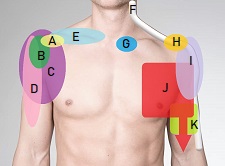- Home
- Elbow Pain Diagnosis
- Forearm Pain
Pain In The Forearm
Written By: Chloe Wilson BSc (Hons) Physiotherapy
Reviewed By: SPE Medical Review Board
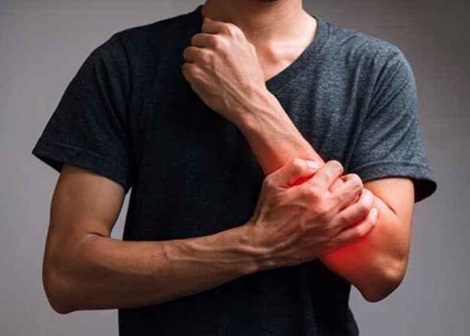
Pain in the forearm is a common problem, typically caused by an injury, repetitive overuse or nerve damage.
Around 5-10% of people will experience forearm pain each year, typically affecting their dominant arm.
There may be pain in the front or back of the forearm which might also extend to the elbow, wrist and/or hand.
Most cases of forearm pain will settle with a combination of home treatments and exercises, but in some cases, steroid injections or surgery may be necessary.
Here we will look at the common causes of pain in the forearm, how to tell which one you have and the best treatment options.
What Makes Up The Forearm?
Forearm pain refers to problems in the area between the elbow and the wrist.
Damage to any of the structures in this region or nearby can cause pain in the forearm:
- Forearm Bones: There are two long bones in the forearm. The radius is found on the thumb side (radial/ lateral side) while the ulna is found on the pinky side (ulnar/medial side). When you have your hand flat, palm facing up, the two bones sit parallel to each other, but when you turn your palm downwards, the radius rotates over the top of the ulna and the bones cross over each other
- Forearm Muscles: There are numerous muscles in the forearm that are responsible for various movements of the wrist, hand and fingers. The forearm muscles are typically thought of in two groups. The anterior (flexor) compartment is found on the front of your forearm (palm up) whereas the posterior (extensor) compartment is found on the back of your forearm (palm down)
- Forearm Nerves: The three main nerves of the forearm are the radial nerve, median nerve and ulna nerve. These three nerves control the forearm muscles and provide sensation to the different parts of the forearm and hand
- Connective Tissues: Ligaments and tendons play a crucial role in connecting bones and muscles in the forearm, providing stability and facilitating movement. A ligaments connects two bones together, and a tendon connect a muscle to a bone
- Blood Vessels: The brachial artery, which branches into the radial and ulnar arteries, supplies blood to the forearms. These arteries, along with accompanying veins ensure proper circulation, allowing the blood to flow properly up and down the arm to the hand
What Causes Forearm Pain?
Pain in the forearm can develop from a number of reasons and is usually caused by:
- Repetitive Strain: Prolonged and repetitive use e.g. gripping, typing, using tools or racket sports, can lead to overuse forearm injuries e.g. tendonitis
- Nerve Pain: Nerve-related issues, often due to compression e.g. carpal tunnel syndrome or cervical radiculopathy can cause numbness, tingling or shooting pain in the forearm
- Trauma/Injury: Accidents, falls, direct blow or other injuries can lead to forearm fractures, sprains, compression, contusions and tears
- Underlying Conditions: certain medical conditions e.g. angina, may cause forearm pain
Right forearm pain is more common than left forearm pain as more often than not, it is the dominant arm that is affected and 85-90% of the population are right handed.
Common Causes Of Forearm Pain
Let’s start by looking at the most common causes of pain in the forearm, how they present and how to work out which one is causing your problem:
1. Forearm Tendonitis
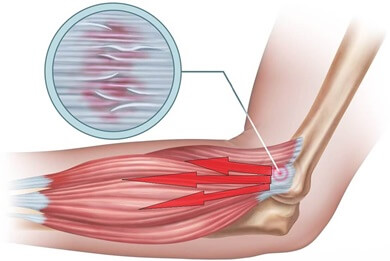
Forearm tendonitis is the most common cause of a dull, aching pain in the forearm.
Typically caused by repetitive overuse, forearm tendonitis occurs when there is irritation or inflammation of one or more of the forearm tendons.
Athletes, office workers and construction workers are particularly prone for pain in the forearm from tendonitis due to the repetitive nature of their activities.
With forearm tendonitis, there is typically an aching or burning pain in the forearm that gets worse with actions like gripping or typing and there is often some associated forearm weakness.
The three main types of tendonitis that cause pain in the forearm are:
- Tennis Elbow: aka Extensor Tendonitis or Lateral Epicondylitis. Tennis elbow causes pain on the outer side of the elbow and lateral forearm pain. Tends to be a burning or aching pain rather than sharp pain and gets worse with gripping and twisting activities. Find Out More >
- Golfers Elbow: aka Flexor Tendonitis or Medial Epicondylitis. Golfers elbow causes pain on the inner side of the elbow and medial forearm pain. Causes tenderness at the inner elbow and pain gets worse when picking things up, carrying heavy bags or twisting. Find Out More >
- Biceps Tendonitis: distal biceps tendonitis causes pain at the front of the elbow and inner forearm pain, typically close to the elbow. Pain in the forearm from biceps tendonitis typically gets worse when bending the elbow or rotating the forearm. Find Out More >
You can find out more about how to treat pain in the forearm from these different types of tendonitis in the forearm tendonitis section.
2. Brachioradialis Pain
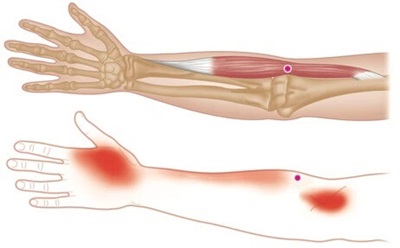
Another common cause of pain in the forearm is brachioradialis muscle pain.
Irritation of the brachioradialis muscle causes outer forearm pain that radiates down the back of the forearm often into the back of the hand, thumb and index finger.
Common activities that cause pain in the forearm from brachioradialis muscle problems include holding a mug, turning door handles, shaking hands, using DIY tools and racket sports.
Brachioradialis pain is another repetitive overuse injury causing pain in the forearm but it can also develop after sudden overloading e.g. picking up a heavy object or a direct blow to the forearm.
You can find out more about brachioradialis pain in the forearm including the common causes, symptoms, diagnosis and best treatment options in the Brachioradialis Pain section
3. Carpal Tunnel Syndrome
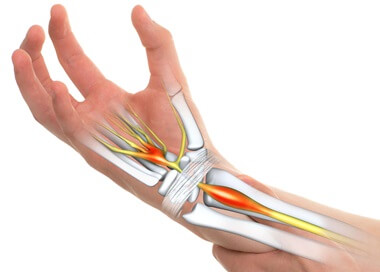
Carpal tunnel syndrome is a common cause of tingling, numbness and pain in the forearm and hand.
It is caused by compression of the median nerve as it travels from the forearm to the hand through a tight, rigid tunnel at the wrist, known as the carpal tunnel.
Anything that reduces the size of the carpal tunnel e.g. swelling from overuse or hormonal changes, arthritis, wrist injuries or certain medical conditions, increases the pressure on the median nerve resulting in nerve irritation.
Common symptoms of carpal tunnel syndrome include tingling, numbness and burning pain in the forearm, wrist and fingers that are often worse at night. You may notice also some weakness in the hand that make it difficult to do fine movements e.g. buttoning clothes, or causes you to drop things.
While carpal tunnel syndrome symptoms are typically worse in the hand, particularly the middle three fingers and thumb, there is often a radiating pain in the forearm too.
4. Cervical Radiculopathy
Compression or irritation of one of the nerves in the lower portion of the neck is another common cause of pain in the forearm, known as cervical radiculopathy.
Forearm pain from cervical radiculopathy may be caused by:
- Disc Disease: degeneration, bulging or herniation of one or more of the discs in the neck cause compression or irritation of the nerve
- Spinal Stenosis: narrowing of the spinal canal from degenerative changes in the neck e.g. bone spurs or arthritis, or spinal injuries e.g. fractures, places increased pressure on the nerves leading to arm nerve pain.
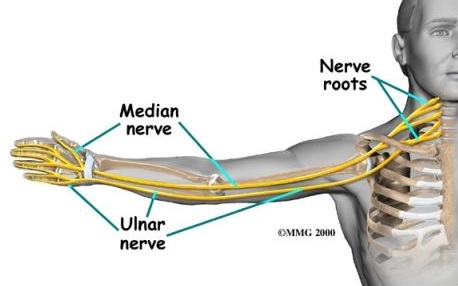
While the problem originates from the neck, symptoms of cervical radiculopathy can be felt anywhere along the path of the nerve between the neck and the hand.
Often, there is no pain in the neck itself, but there may be altered sensation e.g. tingling or numbness and pain further down the arm.
Pain in the forearm from cervical radiculopathy tends to be a sharp, shooting or burning pain, and you may experience sudden, intense sensations similar to an electric shock. There may be weakness as well as pins and needles and/or numbness in the forearm and hand. Symptoms of cervical radiculopathy often get worse when you move your head into a certain position or when sitting slouched for long periods.
You can find out all about how cervical radiculopathy causes pain in the forearm and the different causes, symptoms, diagnosis and treatment options in the Arm Nerve Pain section.
5. Radial Tunnel Syndrome
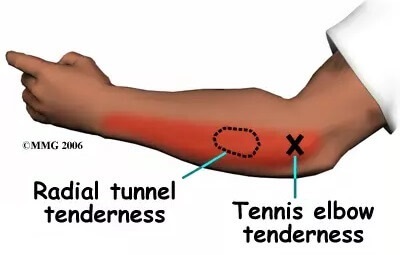
Another possible cause of outer forearm pain and weakness is radial tunnel syndrome, aka radial nerve entrapment.
The radial nerve passes through a small channel on the outer forearm known as the radial tunnel approximately 3cm below the elbow.
Irritation and inflammation of the structures on the outer forearm can reduce the space in the radial tunnel which causes compression and pinching of the radial nerve. The most common cause of pain in the forearm from radial tunnel syndrome is repetitive gripping and twisting movements of the forearm.
Radial tunnel syndrome typically causes outer forearm pain, usually starting midway down the forearm rather than near the elbow. People often describe it as a burning pain or nagging toothache type pain that gets worse with gripping, lifting and twisting activities. The pain in the forearm from radial tunnel syndrome is often worse at night and there may be some weakness in the forearm and wrist.
Unlike other nerve compression problems, radial tunnel syndrome doesn’t usually cause any sensory changes e.g. tingling or numbness as the sensory part of the radial nerve doesn’t pass through the radial tunnel.
Find out more about radial nerve pain in the forearm including the causes, symptoms, diagnosis and treatment options in the Radial Tunnel Syndrome section.
6. Forearm Injuries
Sudden pain in the forearm is often caused by an injury such as a fall or direct blow which damages the soft tissues or bone. Common forearm injuries include:
- Fractures: A break in one of the forearm bones e.g. distal radius fracture, is usually caused by a fall onto an outstretched arm, a direct blow or a road traffic accident. There is usually immediate pain in the forearm accompanied by swelling and bruising and there may be an obvious deformity. Stable fractures (where the bones are still aligned) are usually treated with a cast for 4-6 weeks, followed by physical therapy. However, if the forearm bones have been forced out of alignment, then surgery is usually required
- Sprains/Strain: Sudden overloading or overstretching of one the muscles (strain) or ligaments (sprain) in the forearm causes some or all of the fibres to tear. There may be immediate pain in the forearm or the pain may build-up over 24-48 hours. Heavy lifting, falling with your hand in an awkward position or sudden twisting of the wrist can cause forearm sprains and strains. Most forearm sprains/strains with settle down with rest, ice, medication and exercises within around 3 months, but if there is a complete tear, then surgery is usually necessary
Other Possible Causes
Some other less common causes of pain in the forearm are:
- Arthritis: Arthritis of the elbow or wrist joints can cause a dull, aching pain in the forearm. This may be from rheumatoid arthritis (inflammatory arthritis that often affects multiple joints) or osteoarthritis (wear and tear arthritis)
- Cubital Tunnel Syndrome: Compression of the ulna nerve as it travels along the inner elbow can cause inner forearm pain with tingling and reduced sensation in the ring and little finger along with decreased grip strength
- Heart Problems: e.g. angina can cause pain in the forearm
- Underlying Medical Conditions: e.g. diabetes or thyroid disorders can also cause forearm pain
- Osteomyelitis: an acute infection of the forearm bones is a rare cause of pain in the forearm
Forearm Pain Treatment
The best treatment for pain in the forearm will partly depend on the underlying cause but usually involves a combination of:
- Rest: Avoiding aggravating activities is crucial with forearm pain to allow the affected structures times to heal. As many cases of pain in the forearm are from repetitive overuse, it is really important to avoid aggravating activities otherwise the problem will keep getting worse
- Ice: Regularly applying ice is a great way to reduce forearm pain and inflammation and can help speed up healing. Apply an ice pack for 10-15 minutes at a time, every couple of hours for maximum benefit
- Medications: medications to reduce and swelling and pain in the forearm can be really helpful such as painkillers e.g. paracetamol/acetaminophen and non-steroidal anti-inflammatories e.g. ibuprofen/Advil
- Exercises: Most cases of pain in the forearm will benefit from a combination of stretches and strengthening exercises. Stretches are usually the best place to start as they help to reduce any tightness and tension in the affected structures without overworking the muscles. Once symptoms start to settle, you can then start strengthening exercises which are crucial in making sure the problem doesn’t come back in the future
- Physical Therapy: A physical therapist may recommend a course of deep tissue massage, manipulations, electrotherapy, acupuncture or a specific rehab programme depending on the cause of your pain in the forearm
- Strap Brace: For overuse injuries e.g. tendonitis, wearing a forearm strap helps to reduce the load through the forearm muscles and tendons. They are particularly helpful when returning to your normal activities, be it sports or computer work
- Injections: Some cases of forearm pain respond well to corticosteroid injections to reduce pain and inflammation. The effects of steroid injections may last for anything from a few days to a few weeks and are most effective when combined with other treatments such as exercises and physical therapy
You can find out more about the best treatments for each specific cause of pain in the forearm:
- Forearm Tendonitis Treatment
- Brachioradialis Pain Treatment
- Cervical Radiculopathy Treatment
- Radial Tunnel Syndrome Treatment
- Cubital Tunnel Treatment
Pain In The Forearm Summary
Pain in the forearm is a common problem usually caused by repetitive overuse, nerve damage or trauma.
Forearm pain near the elbow is usually caused by tennis elbow (outer side), golfers elbow (inner side) or biceps tendonitis (front of elbow)
Top of forearm pain is usually caused by forearm tendonitis, brachioradialis pain, an injury e.g. fracture or radial tunnel syndrome
Wrist and forearm pain is usually due to brachioradialis pain (outer side), carpal tunnel syndrome (tingling and numbness in hand) or a wrist fracture from a fall
Thumb and forearm pain is usually due to brachioradialis pain or nerve damage
Nerve pain in the forearm is usually a burning, sharp or stabbing pain often accompanied by tingling or numbness, usually due to nerve compression in the neck, radial tunnel, cubital tunnel or carpel tunnel
Shoulder and forearm pain is usually caused by a nerve problem in the neck. It is very rare for a problem in the shoulder to refer pain below the elbow unless one of the nerves is involved
A sharp pain in the forearm is usually due to a fracture or nerve pain
Right forearm pain is much more common than left forearm pain as a vast majority of the population is right handed
You may also be interested in the following articles:
- Inner Elbow Pain
- Outer Elbow Pain
- Pain Behind The Elbow
- Elbow Range Of Motion
- Restless Arm Syndrome
- Lump On Elbow
Page Last Updated: March 21st, 2024
Next Review Due: March 21, 2026
Related Articles
Shoulder Problems
September 26, 2023
Diagnosis Charts
September 28, 2023
Rehab Exercises
December 12, 2023
Medical & Scientific References
- Predicting the onset of forearm pain: A prospective study across 12 occupational groups. Arthritis Care & Research Journal
- Effect of specific resistance training on forearm pain and work disability in industrial technicians: cluster randomised controlled trial. British Medical Journal Open
- Role of mechanical and psychosocial factors in the onset of forearm pain: prospective population based study. British Medical Journal

